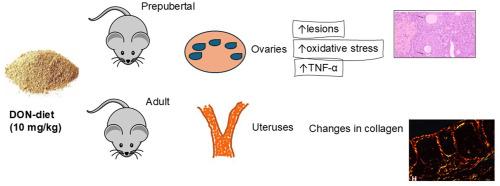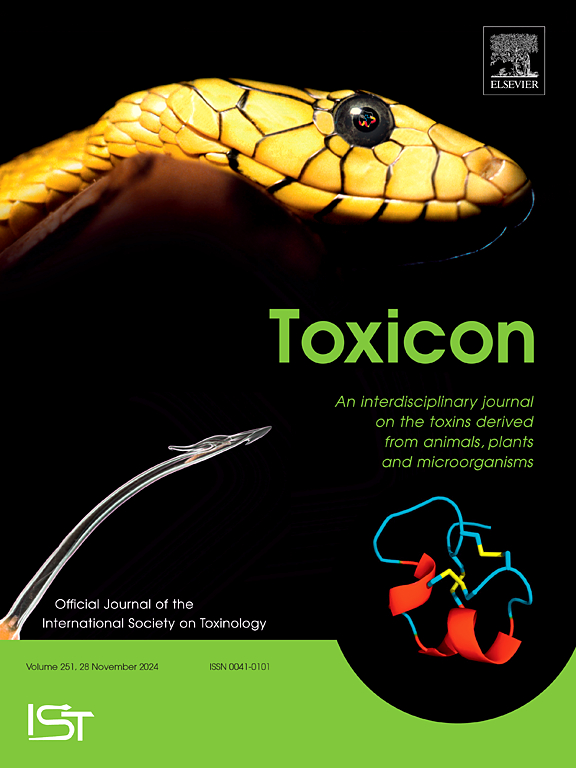Deoxynivalenol induces ovarian damage and uterine changes in prepubertal and adult mice
IF 2.6
4区 医学
Q2 PHARMACOLOGY & PHARMACY
引用次数: 0
Abstract
Deoxynivalenol (DON) is associated with reproductive toxicity in animals. The frequent contamination of cereal-based foods with DON and the high intake of these by children raises particular concern about the susceptibility of this subpopulation to adverse effects from this mycotoxin. However, age-related differences in the in vivo reproductive toxicity of DON have not been evaluated. Therefore, the effects of DON on serum follicle-stimulating hormone (FSH) levels, histology, and inflammatory and oxidative stress responses in the ovaries and uteruses of prepubertal and adult mice were investigated. Twenty female prepubertal Swiss mice (21 days old) and 20 young adult mice (65 days old) were fed a control diet or a diet containing 10 mg of DON/kg of feed for 15 days (prepubertal mice) and 28 days (adult mice). In the ovaries, DON induced an increase in the lesional score in both age groups. Ingestion of DON decreased FSH levels in prepubertal females, whereas an increase was observed in adult mice. In prepubertal mice, a reduction in the number of macrophages and increased levels of TNF-α were observed in the ovaries of the DON group, while in adult animals, an increase in the number of macrophages and higher levels of TNF-α were noted. Exposure to DON led to an increase in type I collagen in the uteruses of adult mice, while in prepubertal mice, a decrease in type III collagen was observed. DON exposure also resulted in a decrease in FRAP levels and an increase in ABTS and lipid peroxidation in the uteruses of prepubertal mice. Taken together, the results indicate that the effects of DON on reproductive organs are age-specific, with toxicity established as early as the prepubertal period.

脱氧雪腐镰刀菌烯醇可诱导青春期前小鼠和成年小鼠的卵巢损伤和子宫变化。
脱氧雪腐镰刀菌烯醇(DON)与动物的生殖毒性有关。谷物类食品经常受到 DON 污染,而儿童又摄入了大量此类食品,这就特别令人担忧这部分人群是否容易受到这种霉菌毒素的不良影响。然而,DON 的体内生殖毒性与年龄有关的差异尚未得到评估。因此,我们研究了 DON 对青春期前小鼠和成年小鼠卵巢和子宫中血清促卵泡激素(FSH)水平、组织学以及炎症和氧化应激反应的影响。给 20 只青春期前的雌性瑞士小鼠(21 天大)和 20 只年轻的成年小鼠(65 天大)喂食对照组饲料或每公斤饲料含 10 毫克 DON 的饲料,分别喂食 15 天(青春期前小鼠)和 28 天(成年小鼠)。在两个年龄组的小鼠卵巢中,DON 都会导致病变评分增加。摄入 DON 会降低青春期前雌性小鼠的 FSH 水平,而成年小鼠的 FSH 水平会升高。在青春期前的小鼠中,DON 组卵巢中的巨噬细胞数量减少,TNF-α 水平升高,而在成年动物中,巨噬细胞数量增加,TNF-α 水平升高。青春期前动物的子宫组织出现水肿,子宫壁和子宫内膜厚度增加。暴露于 DON 会导致成年小鼠子宫中 I 型胶原蛋白的增加,而在青春期前的小鼠中则观察到 III 型胶原蛋白的减少。暴露于 DON 还会导致 FRAP 水平下降,以及青春期前小鼠子宫中 ABTS 和脂质过氧化反应的增加。总之,这些结果表明,DON 对生殖器官的影响具有年龄特异性,其毒性早在青春期前就已确立。
本文章由计算机程序翻译,如有差异,请以英文原文为准。
求助全文
约1分钟内获得全文
求助全文
来源期刊

Toxicon
医学-毒理学
CiteScore
4.80
自引率
10.70%
发文量
358
审稿时长
68 days
期刊介绍:
Toxicon has an open access mirror Toxicon: X, sharing the same aims and scope, editorial team, submission system and rigorous peer review. An introductory offer Toxicon: X - full waiver of the Open Access fee.
Toxicon''s "aims and scope" are to publish:
-articles containing the results of original research on problems related to toxins derived from animals, plants and microorganisms
-papers on novel findings related to the chemical, pharmacological, toxicological, and immunological properties of natural toxins
-molecular biological studies of toxins and other genes from poisonous and venomous organisms that advance understanding of the role or function of toxins
-clinical observations on poisoning and envenoming where a new therapeutic principle has been proposed or a decidedly superior clinical result has been obtained.
-material on the use of toxins as tools in studying biological processes and material on subjects related to venom and antivenom problems.
-articles on the translational application of toxins, for example as drugs and insecticides
-epidemiological studies on envenoming or poisoning, so long as they highlight a previously unrecognised medical problem or provide insight into the prevention or medical treatment of envenoming or poisoning. Retrospective surveys of hospital records, especially those lacking species identification, will not be considered for publication. Properly designed prospective community-based surveys are strongly encouraged.
-articles describing well-known activities of venoms, such as antibacterial, anticancer, and analgesic activities of arachnid venoms, without any attempt to define the mechanism of action or purify the active component, will not be considered for publication in Toxicon.
-review articles on problems related to toxinology.
To encourage the exchange of ideas, sections of the journal may be devoted to Short Communications, Letters to the Editor and activities of the affiliated societies.
 求助内容:
求助内容: 应助结果提醒方式:
应助结果提醒方式:


